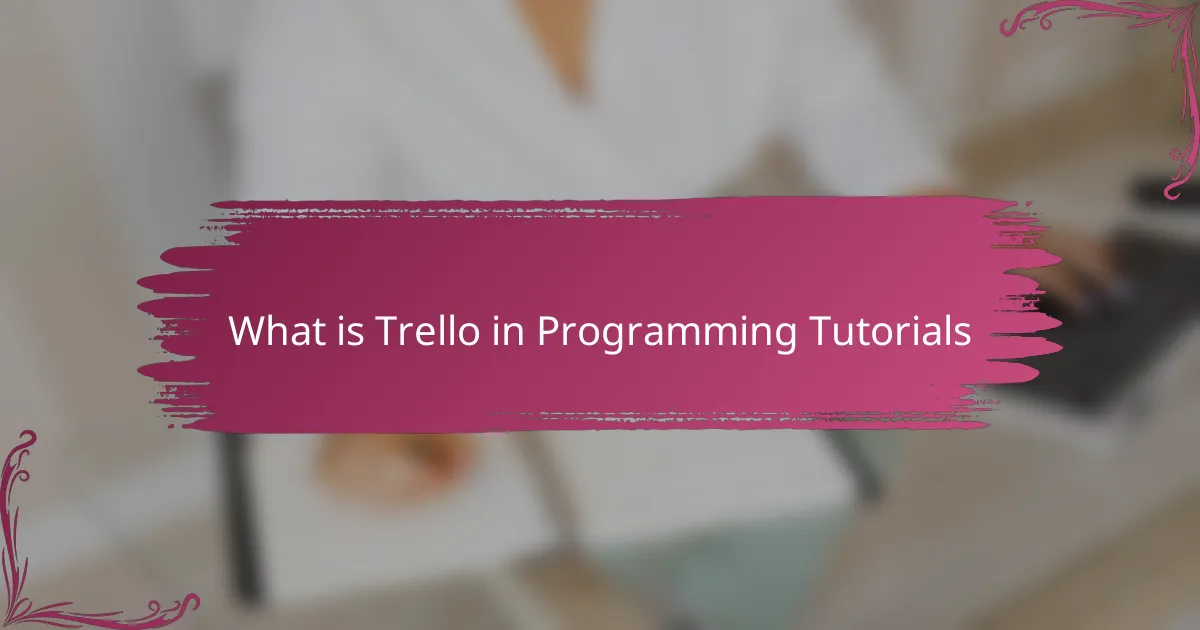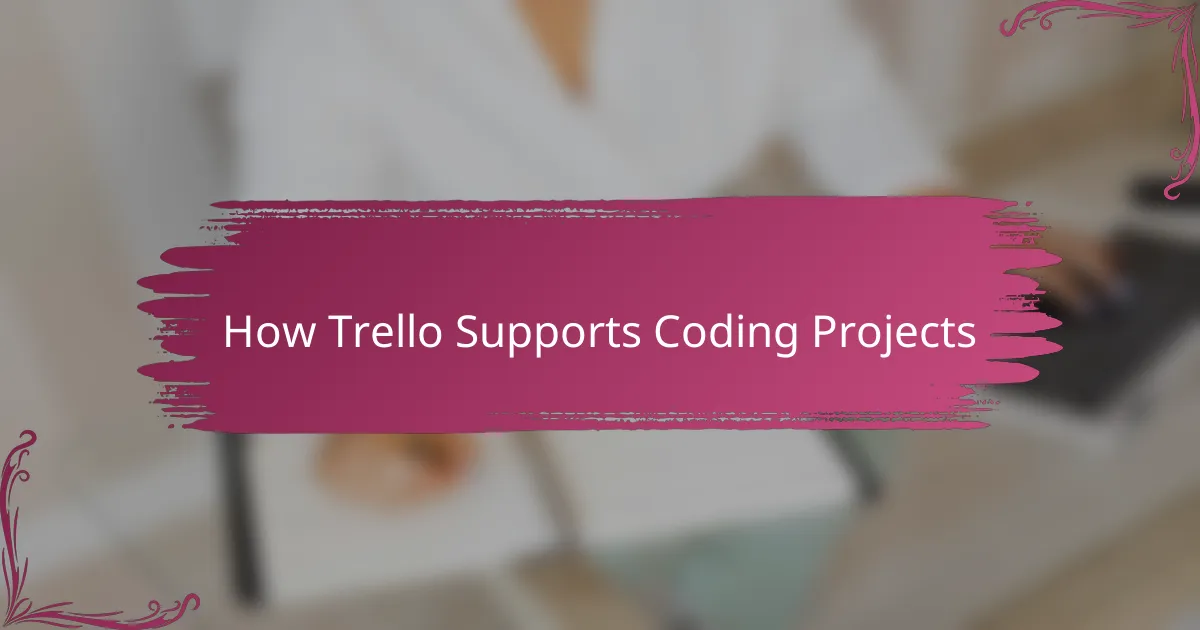Key takeaways
- Trello transforms complex programming tasks into manageable pieces through visual organization, enhancing focus and satisfaction.
- The platform facilitates team collaboration with features like task assignment and direct commenting, minimizing miscommunication.
- Using Trello’s customization options, such as labels and checklists, helps prioritize tasks effectively and keeps productivity high.
- Regularly updating boards and integrating relevant information supports clear progress tracking and builds a sense of achievement.

What is Trello in Programming Tutorials
Trello, in the context of programming tutorials, serves as a visual task management tool that helps organize coding projects into boards, lists, and cards. When I first started using Trello for tracking my learning milestones, it felt like finally having a clear roadmap through what initially seemed like a tangled web of concepts.
Have you ever felt overwhelmed trying to keep track of various programming assignments and tutorials? Trello breaks that chaos down into manageable pieces, allowing me to focus on one task at a time without losing sight of the bigger picture. This approach makes learning not just structured but also strangely satisfying.
From my experience, Trello’s simple drag-and-drop interface mirrors the step-by-step mindset needed in programming. Each card can hold code snippets, notes, or links, which makes revisiting previous lessons easy and less frustrating — something I appreciate deeply when debugging or revisiting complex topics.

Benefits of Using Trello for Project Management
One of the biggest benefits I’ve found using Trello for project management is how it instantly brings clarity to a maze of tasks. When I’m juggling multiple coding projects or deadlines, having everything visually laid out in boards and lists feels like suddenly switching on a light in a dark room. It’s easier to prioritize, so I never waste time wondering what I should tackle next.
I also appreciate how Trello’s collaboration features make teamwork smoother. Have you ever struggled with miscommunication in a group project? With Trello, commenting directly on cards and assigning tasks means fewer emails and less confusion. From my own experience, this keeps the whole team on the same page—and it actually makes coding sprints less stressful.
Another thing I can’t ignore is Trello’s flexibility. Whether I’m working on a simple app or a complex system, I customize boards with labels, due dates, and checklists that match my workflow. It feels empowering to shape my project space exactly how I want, instead of being boxed into one rigid method. This freedom keeps me motivated and more productive.

Key Trello Features for Programmers
One feature that immediately caught my attention as a programmer is Trello’s ability to integrate code snippets and attachments directly into task cards. Have you ever needed to reference a piece of code or documentation quickly without digging through folders? For me, having everything centralized on a card saves precious time and keeps my focus sharp.
Labels and custom fields in Trello also stand out as crucial for managing the complexity of programming projects. I like to color-code tasks based on priority or type—like bugs, features, or refactoring. This visual tagging helps me instantly spot what needs urgent attention, preventing those last-minute coding panics we all dread.
Lastly, the power of Trello’s calendar and due date features can’t be overstated. They keep me accountable, especially during tight sprints or when deadlines sneak up unexpectedly. I’ve found that having clear timelines right in front of me nudges me to stay on track, even when distractions loom large.

How Trello Supports Coding Projects
When managing coding projects, Trello has been a game changer for me. I recall a time when I was buried under multiple feature requests and debugging tasks; moving cards across lists to reflect progress gave me a real sense of accomplishment. It’s like watching your code come alive, step-by-step, but in an organized, visual way that keeps me motivated.
I’ve noticed how Trello’s board structure mirrors the modular nature of coding itself. Breaking a project into tasks such as “To Do,” “In Progress,” and “Testing” feels natural and helps me focus on one piece without losing sight of dependencies. Have you ever struggled with tracking which part of your codebase needed attention next? Trello solved that for me by making workflow obvious at a glance.
One small but powerful habit I’ve developed is attaching pull request links and error logs directly to Trello cards. This might sound simple, but it keeps everything connected—no more hunting through emails or chat threads. For me, this integration means less time wasted switching contexts and more time writing clean, working code.

Personal Experience Using Trello in Programming
When I first started using Trello for programming projects, I didn’t expect it to make such a difference. I remember juggling multiple features and bugs, and suddenly, dragging cards from “To Do” to “Done” gave me a surprising boost of satisfaction. It felt like I was making tangible progress, not just staring at lines of code.
Have you ever found yourself losing track of where a bug was or which feature needed testing next? Trello helped me because its visual layout mirrors how I think about code—step by step, module by module. That clarity made it easier for me to prioritize tasks without feeling overwhelmed.
One habit I can’t quit is attaching pull requests and error logs right on the cards. It keeps all relevant info in one spot, so I’m not scrambling through emails or messages. From my experience, that small practice saves me time and mental energy, allowing me to focus on what I really enjoy: coding.

Tips for Effectively Managing Projects with Trello
One tip I’ve found invaluable is to keep your Trello boards simple and focused. When I tried juggling too many lists or labels at once, things got messy quickly. So now, I stick to a few clear columns like “To Do,” “In Progress,” and “Done” — this straightforward setup keeps me sane and projects moving smoothly.
Have you ever struggled with losing track of deadlines? I make good use of Trello’s due dates and calendar integrations to hold myself accountable. Setting reminders and seeing deadlines visually helps me avoid last-minute rushes and reduces unnecessary stress.
Finally, don’t underestimate the power of consistent updates. I’ve learned that regularly moving cards and adding comments not only tracks progress but also gives me a real sense of achievement. It’s like celebrating small wins, which keeps my motivation high even when the coding gets tough.

Lessons Learned from Trello Use in Programming
One lesson I’ve learned using Trello in programming is how important it is to keep tasks bite-sized. Have you ever felt stuck staring at a giant, vague to-do list? Breaking down features or bugs into smaller cards made the work feel less intimidating and gave me a steady sense of forward momentum.
I also realized that visual progress matters more than I expected. Moving cards from “In Progress” to “Done” gave me a genuine feeling of accomplishment, almost like ticking off lines of code. It’s funny how a simple drag-and-drop can motivate you to push through the tough debugging sessions.
Lastly, integrating all project-related info directly into Trello cards—like pull requests or error logs—was a game changer. It saved me from endless searching through emails or chat groups and kept my focus sharp. Have you tried this? From my experience, it’s a small habit with big rewards.